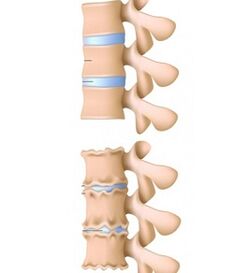
What are the causes of cervical osteochondrosis? What are the symptoms? How to effectively treat cervical osteochondrosis at home?
Cervical osteochondrosis is one of the common diseases that increasingly affects young people (25 to 40 years old). Prolonged stay in the wrong, tense posture — for example, working with a computer during the day or the habit of supporting the telephone on the shoulder — helps to develop osteochondrosis of the cervix.
It is often caused by prolonged vibration, such as when working with construction machinery or driving a car. Improper posture, uncomfortable bed, sedentary lifestyle, hereditary predisposition and other factors can also lead to cervical osteochondrosis.
Cervical osteochondrosis and its causes
Cervical osteochondrosis is a degenerative-dystrophic lesion of the intervertebral disc in the cervical spine. It occurs in the background of metabolic disorders of the cervical spine, in which the structure of the intervertebral plates (special spacers between the vertebrae) and the bodies of the vertebrae themselves change.
In terms of symptoms, osteochondrosis of the neck is somewhat different from osteochondrosis of the rest. This is the most dangerous type of osteochondrosis, as it often leads to damage to the root of the nerve that extends from the spinal cord and disruption of the blood supply to the brain due to compression of the blood vessels. This is due to the peculiarities of the anatomical structure of the spine in the cervical zone. So one of the large arteries that feeds the brain - the vertebra - passes precisely through the openings in the processes of the cervical vertebrae. Therefore, the pathological changes that occur in them — the proliferation of bone and fibrous tissue, the displacement of the vertebrae — interfere with the normal functioning of this artery.
In addition, the structure of the spinal column in the cervical spine is slightly different - the vertebrae are more closely adjacent to each other. Therefore, any, even insignificant, pathological change in one vertebra interrupts the normal functioning of the entire section - depression or displacement of nerves and blood vessels, and more frequent compression of the spinal cord than lumbar or thoracic osteochondrosis. As a result, significant dysfunctions can be observed in osteochondrosis of the neck - disturbances in the sensitivity of the skin and muscles of the neck, face, hands, dizziness. There may be noise or ringing in the ears and head, persistent headaches, increased fatigue, blurred vision and hearing, insecurity while walking, and so on.
Symptoms of cervical osteochondrosis

Among the symptoms of cervical osteochondrosis, the following are noted:
- Pain in the neck, back of the head, shoulders or arms. In addition, weakness of the arm muscles, difficulty moving the head, cracking of the neck when turning or tilting the head to the side are often observed.
- Frequent stretching pain occurs on the left side of the chest, radiating toward the left arm. There may be a burning sensation or pain between the shoulder blades.
- Cervical osteochondrosis causes recurrent headaches, feelings of weakness and increased fatigue. As a general rule, the pain is painful in nature and is concentrated on the side and back of the neck and the back of the head. Patients often have difficulty moving their heads, especially when they turn in different directions.
- Neck pain can radiate to the arm and spread from shoulder to hand, numbness of the fingers. In this case, patients sometimes complain of "itching" or "passage of electric current" along the arms and legs when the neck is bent.
- Cervical osteochondrosis can also cause hearing and vision loss, hand pain, heart and lung problems, dizziness, nausea, double vision, numbness of the face and tongue.
What is cervical osteochondrosis? What are the symptoms? How to treat cervical osteochondrosis?
Treatment of osteochondrosis of the neck
As a general rule, osteochondrosis of the neck begins in a mild form and does not cause any particular discomfort to the person at first. Medical treatment at this stage is usually not necessary, just enough to prevent further complications, improve working conditions, and review lifestyles for the benefit of healthier people.
To prevent osteochondrosis of the cervix, you should lead an active lifestyle, exercise morning, follow a moderate calorie diet, get rid of bad habits, and avoid heavy lifting. A rigid posture, proper posture while sitting and sleeping, a comfortable bed is also an important factor in its prevention. Physiotherapy courses will also be helpful.
However, as we age, cervical osteochondrosis progresses and can flow into more serious forms. In this case, the treatment of cervical osteochondrosis is performed by conservative methods. Among them: wearing a special collar, physiotherapy, exercise, massage. In more severe cases, the patient may need medication - painkillers, antispasmodics, non-steroidal anti-inflammatory drugs (NSAIDs). Physiotherapy procedures are also prescribed (paraffin, medical electrophoresis, etc. ).
Chondroprotectors as well as B vitamins (B6, B12) are presented for the treatment of chronic osteochondrosis of the cervical spine. Medicines for external use are widely used - ointments, creams, gels that contain non-steroidal anti-inflammatory drugs, local irritants and tissue regenerating stimulants.
Recently, a new drug has appeared in pharmacies that can be of great help in treating cervical osteochondrosis - a therapeutic analgesic anti-inflammatory patch.
Treatment of cervical osteochondrosis with a medical patch
Various agents are used in the therapeutic treatment of cervical osteochondrosis, such as NSAIDs, analgesics, antispasmodics. All of these funds are effective, but can be harmful to the body if used for extended periods of time. Therefore, it is very important to minimize side effects and improve the effectiveness of treatment. A new generation of drugs - anesthetic anti - inflammatory medical patch - can help with this.
The healing patch is very effective, allowing you to relieve pain and inflammation, improve blood circulation in the affected area, and reduce the dose of painkillers and anti-inflammatory drugs.
In the treatment of osteochondrosis of the neck, a medical patch is applied to the disturbing area of the neck, avoiding the anterior surface, especially the area of the carotid arteries and lymph nodes. A course of 9 days or more is recommended. It is usually recommended to use the patch at 12 noon, but it can also be used at night.
High efficacy, uniqueness of the formulation, long-term therapeutic effect, ease of use and affordable price make the medical patch the tool of choice for the treatment of cervical osteochondrosis.






















